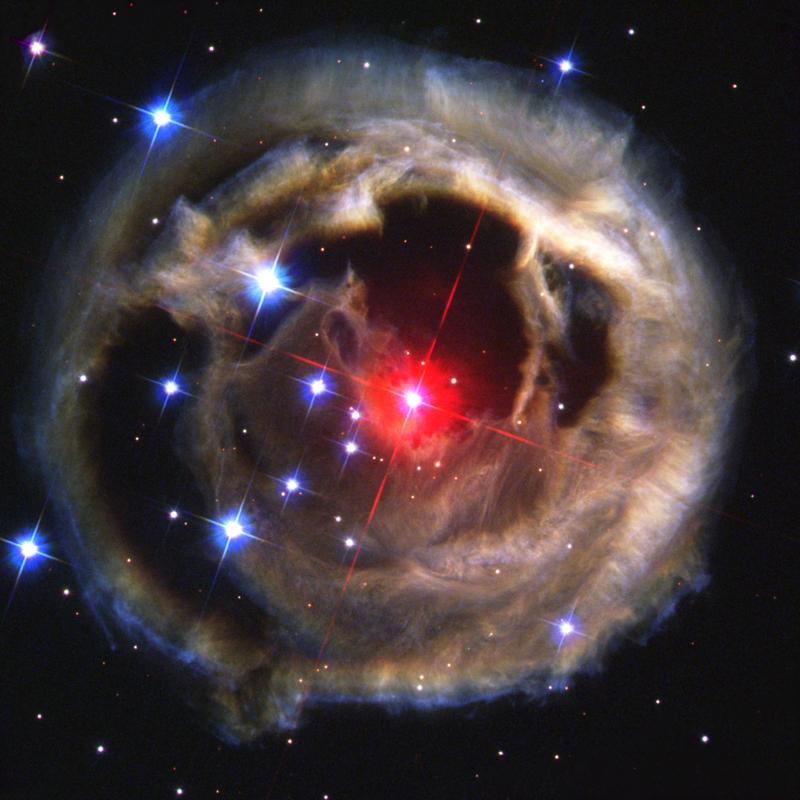







| BOOKS | F. A. Q. | ARTICLES | TALKS | ABOUT KEN | DONATE | BEYOND OUR KEN |
|---|
By Ken Croswell
Published on New Scientist (May 13, 2016)

V838 Monocerotis is the best-known red nova. Credit: Hubble Space Telescope. NASA, ESA, Howard E. Bond (STScI) and The Hubble Heritage Team (STScI/AURA).
Call it a case of cosmic indigestion. A large star swallowing its smaller companion sparked a brilliant explosion recently seen in the nearby Andromeda galaxy – and the basic physics was worked out by one of Charles Darwin’s sons almost 150 years ago.
In January 2015, observers witnessed a rare “red nova”, which outshines ordinary novae – stars that show a sudden brightening before returning to their original state. At peak brightness, it emitted half a million times more light than the Sun and rivalled the brightest stars in the Andromeda galaxy, which is 2.5 million light-years away.
In 2008, a red nova in our Galaxy named V1309 Scorpii proved pivotal to understanding these odd eruptions. By good luck, astronomers were able to compare their observations with existing data taken prior to the explosion. This showed that the event was the result of two similar stars spiralling around each other and merging into one. The merger kicked out gas that expanded and cooled, giving the nova a red cast.
The red nova in Andromeda, M31LRN 2015, may prove equally illuminating, because — again by luck — the Hubble Space Telescope happened to observe the star a decade earlier.
Now Morgan MacLeod of the University of California at Santa Cruz and his colleagues have concluded that a large yellow star ate a little red one. “It’s a star-eat-star universe out there,” he says.
Yellow giant, red dwarf
The differences between the stars involved made the 2015 merger more violent than the 2008 one, MacLeod says. The Hubble observations show that the yellow star was a giant about four times as massive as the sun and 35 times its size.
The little star was too dim for Hubble to see, but models suggest it was a red dwarf with between 10 and 60 per cent of the Sun’s mass.
Normally, in a close binary, the gravitational pull of one star keeps the other rotating as fast as it revolves so that one side of one star always faces the same side of the other star.
But because of its lower mass, the red dwarf was vulnerable to the Darwin instability, an idea that George Darwin, one of Charles’s sons, proposed in 1879. As the yellow giant star aged, it expanded and spun more slowly, just as spinning ice skaters do when extending their arms. The red star couldn’t keep its partner facing it and began to fall toward it, eventually skimming the surface, which shocked the gas and triggered the flare-up.
Friction then dragged the red star inside the yellow one. Within only about 40 days, the red star ceased to exist.
Ken Croswell earned his Ph.D. in astronomy from Harvard University and is the author of The Alchemy of the Heavens and The Lives of Stars.
"An engaging account of the continuing discovery of our Galaxy...wonderful." --Owen Gingerich, The New York Times Book Review. See all reviews of The Alchemy of the Heavens here.
"A stellar picture of what we know or guess about those distant lights."--Kirkus. See all reviews of The Lives of Stars here.
| BOOKS | F. A. Q. | ARTICLES | TALKS | ABOUT KEN | DONATE | BEYOND OUR KEN |
|---|